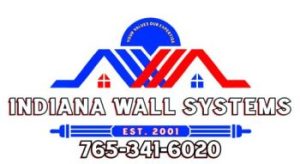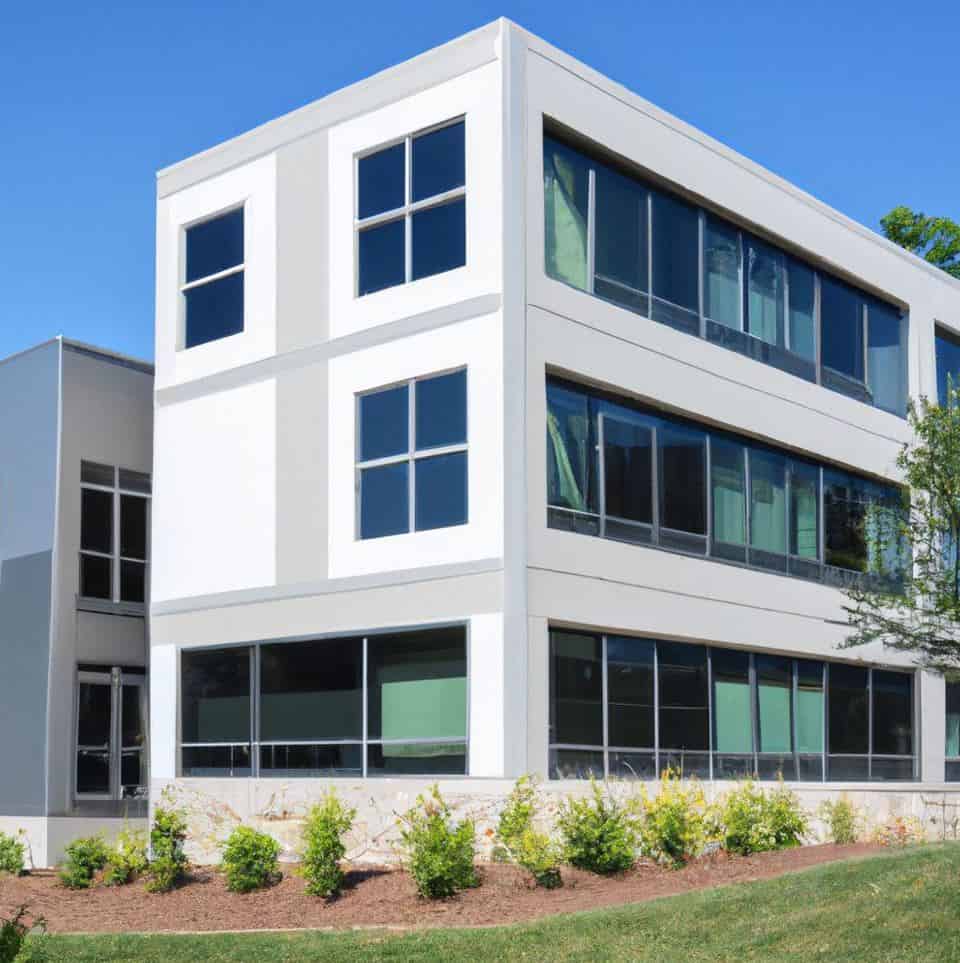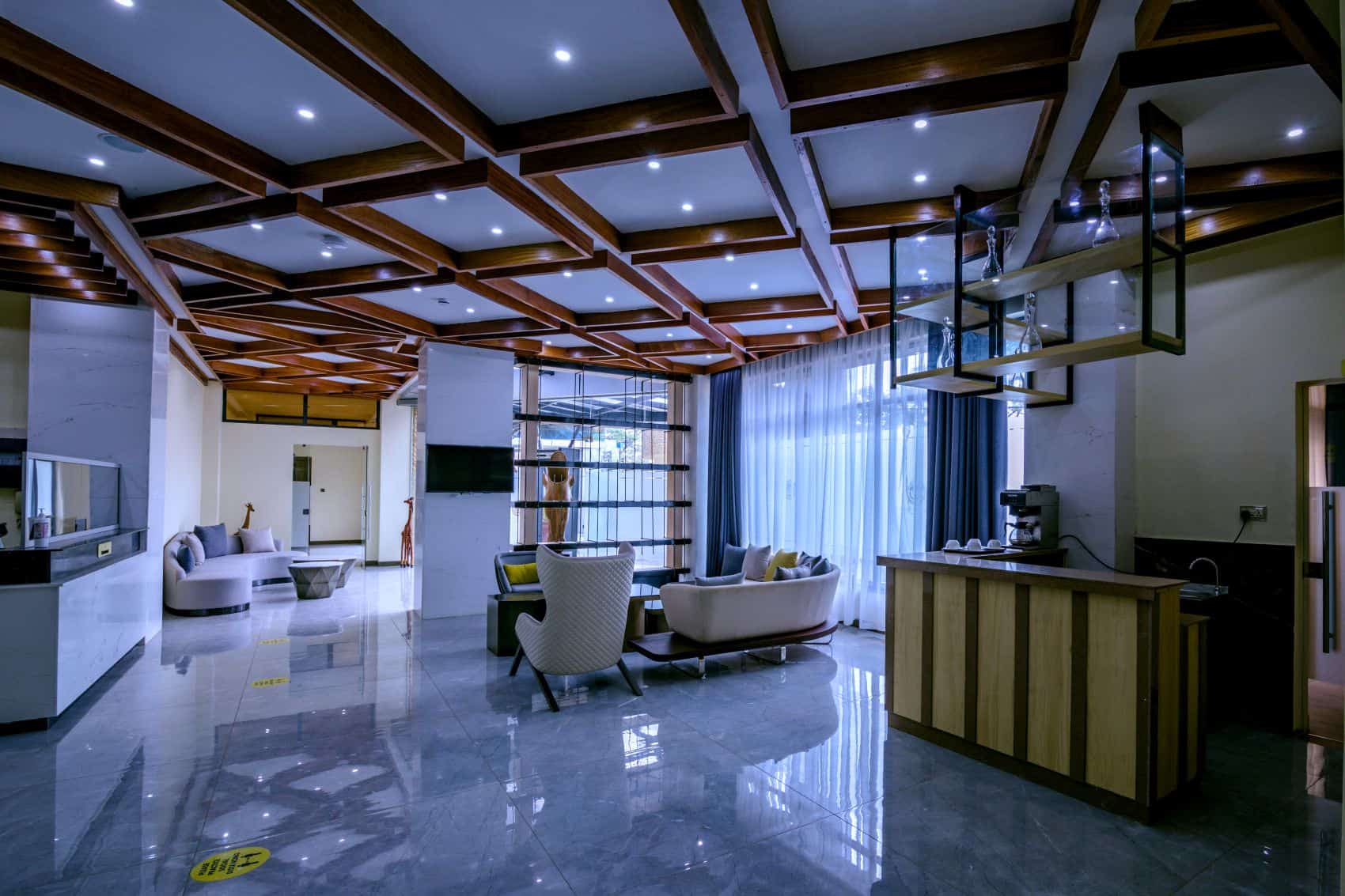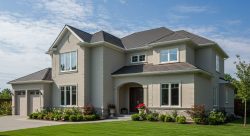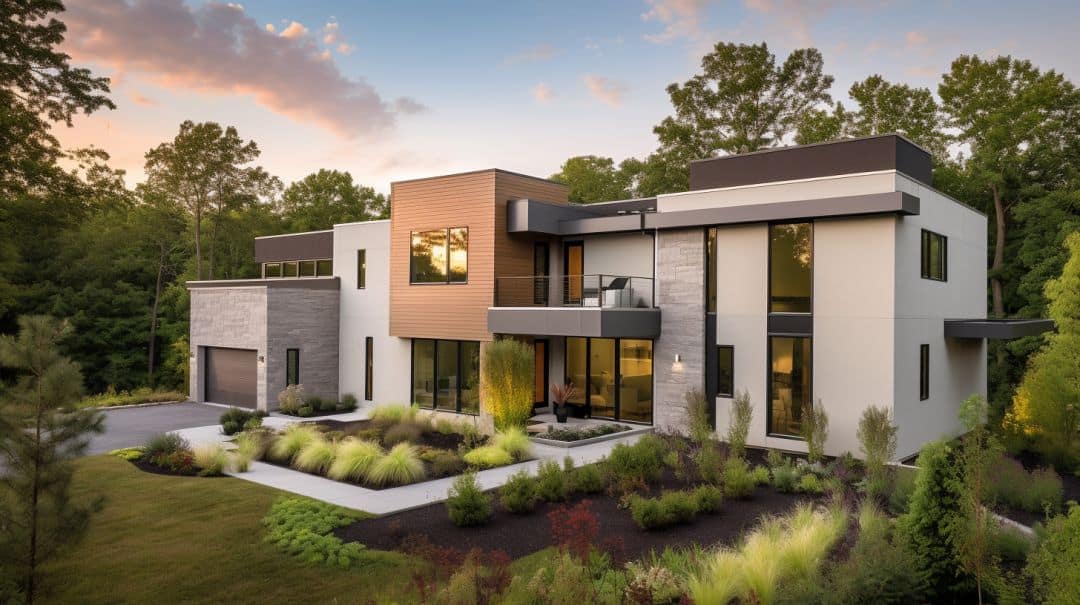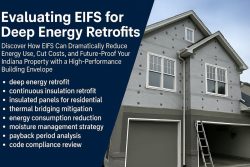How Exterior Insulation and Passive Design Unite to Cut Energy Costs, Improve Comfort, and Future-Proof Indiana Homes
Are you looking to slash your energy bills while creating a more comfortable home? As someone who’s spent over two decades in the EIFS business, I’ve seen firsthand how exterior insulation can transform a building’s performance. But when you combine EIFS technology with Passive House design principles, you’re entering a whole new level of energy efficiency that most Indiana homeowners haven’t even considered yet.
With energy costs constantly rising and climate concerns growing, more property owners are asking how they can make their buildings more efficient. The answer might be simpler than you think.
Key Takeaways
- Exterior Insulation and Finish Systems (EIFS) perfectly align with Passive House standards by providing continuous insulation without thermal bridges
- EIFS can help reduce heating and cooling energy use by up to 50% when properly integrated into a Passive House design
- The combination of EIFS and Passive House principles creates superior indoor air quality and occupant comfort year-round
- EIFS contributes significantly to meeting the rigorous airtightness requirements of Passive House certification
- Modern EIFS with drainage provides both energy efficiency and excellent moisture management for sustainable buildings
Annual Heating & Cooling Energy Usage
What Is Passive House Design?
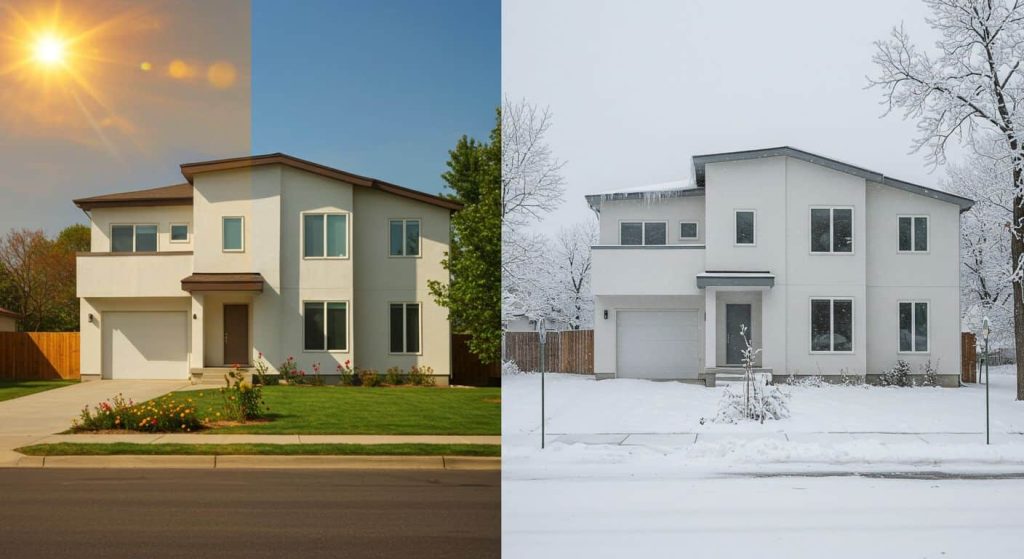
When I’m talking to clients about energy-efficient construction, the term “Passive House” often draws curious looks. Let me break it down in simple terms.
Passive House is a building standard that focuses on creating ultra-efficient buildings that maintain comfortable temperatures year-round with minimal energy input. It’s not just a style of architecture – it’s a precise, performance-based approach to building design.
The Passive House standard originated in Germany (where it’s called “Passivhaus”), but it’s gaining serious traction here in the United States, including right here in Indiana. Why? Because a properly designed Passive House can reduce energy consumption by up to 90% compared to conventional buildings.
The core principles of Passive House include:
- Superinsulation: Much thicker insulation than typical code requirements
- Airtight construction: Virtually eliminating air leaks and drafts
- Thermal bridge-free design: Preventing heat from escaping through framing materials
- High-performance windows and doors: Usually triple-glazed with insulated frames
- Heat recovery ventilation: Providing fresh air without losing heat
- Optimal solar orientation: Using the sun’s energy strategically
In my 22 years of EIFS experience at Indiana Wall Systems, I’ve seen the building industry gradually embrace better energy performance. But Passive House takes energy efficiency to an entirely different level. And here’s where it gets interesting: EIFS is one of the best cladding systems for achieving Passive House standards.
Why EIFS is Ideal for Passive House Construction
When architects and builders start planning a Passive House project, they quickly realize that the building envelope is everything. The walls, roof, and foundation need to work together as a continuous thermal barrier. This is exactly where EIFS shines brightest.
Continuous Insulation Without Thermal Bridging
One of the main requirements for Passive House certification is eliminating thermal bridges – those areas where heat can escape through structural elements like studs or joists. With traditional stud wall construction, even when you fill the cavity with fiberglass insulation, the studs themselves create thermal bridges that significantly reduce the wall’s overall R-value.
Thermal Bridging Comparison
EIFS solves this problem beautifully by providing a continuous layer of insulation on the outside of the structure. This EPS (expanded polystyrene) insulation wraps the entire building, including over studs and other structural components, eliminating those pesky thermal bridges.
I’ve installed EIFS on countless projects across Indiana, and when we thermally image these buildings afterward, the difference is striking – an even temperature across the entire wall surface with no cold spots where studs or headers would normally create heat loss paths.
Superior R-Value and Thickness Flexibility
Passive House designs typically need wall assemblies with much higher R-values than conventional construction. While standard homes might have R-13 or R-19 walls, Passive House walls often require R-40 or higher.
Typical Wall Assembly R-Values
EIFS gives us incredible flexibility here. We can adjust the thickness of the EPS insulation layer to meet the exact R-value needed for a specific climate zone. Here in Indiana (climate zone 3), a Passive House typically needs thicker insulation than in warmer southern states, and EIFS makes achieving these higher R-values straightforward.
I remember one project in Carmel where we installed a 6-inch thick EIFS system that, combined with the structural wall assembly, achieved an impressive R-45. The client was amazed at how quiet and temperature-stable their home became.
Airtightness Partner
Passive House requires exceptional airtightness – typically less than 0.6 air changes per hour at 50 Pascals pressure (as measured by a blower door test). This is dramatically tighter than conventional construction.
While EIFS itself isn’t the primary air barrier (that’s typically a specialized membrane applied to the sheathing), it works in perfect harmony with the air barrier system. The continuous insulation layer helps protect the air barrier from temperature extremes and physical damage, extending its effectiveness and lifespan.
In our projects, we pay special attention to sealing all expansion joints and penetrations through the EIFS to maintain this crucial airtightness. The lamina (base coat with embedded mesh and finish coat) also provides an additional weather-resistant barrier that further enhances the wall’s airtight performance.
Moisture Management Excellence
Modern EIFS with drainage capabilities provides excellent moisture management – another critical aspect of durable, sustainable building envelopes. The drainage plane design allows any incidental moisture that might get behind the system to safely drain out, preventing the issues that plagued some older EIFS installations.
For Passive House projects, this moisture management is particularly important because the high insulation levels mean the wall assembly operates at different temperature gradients than conventional walls. This can change where condensation might occur within the assembly, making proper water management essential.
Real-World Performance: EIFS in Passive House Projects
Let’s look at some real-world examples that showcase how EIFS and Passive House principles work together to create exceptional buildings.
Case Study: Multi-Family Passive House in the Midwest
One of the most impressive projects I’ve been involved with was an 11-story affordable senior housing development that used EIFS as part of its Passive House strategy. This project demonstrated that Passive House isn’t just for luxury homes – it can and should be accessible for all housing types, including affordable housing.
Project Snapshot
- Property Type: 11-story affordable senior housing, Midwest
- System Used: 4-inch EIFS with drainage plane over continuous air barrier
- Performance: Reduced heating/cooling costs by 65% compared to code minimum
- Certification: PHIUS+ 2018 Certified
The architects originally considered several different cladding options but ultimately chose EIFS because it offered the best combination of continuous insulation, design flexibility, and cost-effectiveness. The project team was able to create a building with bold design elements like curved corners and varied surface textures – all while maintaining the strict thermal performance needed for Passive House certification.
Most importantly, the residents now enjoy incredibly stable indoor temperatures and drastically reduced utility bills.
Indiana Home Retrofit Achieves Near-Passive Standard with EIFS

Closer to home, we recently completed a retrofit of an existing home in Indianapolis that approached Passive House standards using EIFS as the primary insulation and cladding strategy.
The 1970s home had typical issues: drafty rooms, high energy bills, and uncomfortable temperature variations. By applying a 3-inch EIFS system over the existing brick veneer, we transformed its performance. While not pursuing formal Passive House certification, the project followed many Passive House principles and achieved remarkable results.
The homeowners reported a 58% reduction in their energy bills the first year after completion. They also noted that temperature variations between rooms had virtually disappeared, and they no longer felt drafts near exterior walls.
What’s fascinating about this project is that we were able to preserve the home’s character while dramatically improving its performance. The versatility of EIFS finishes allowed us to match the appearance of the original brick, maintaining the home’s aesthetic while transforming its energy efficiency.
How EIFS Contributes to Specific Passive House Requirements
Let’s break down exactly how EIFS helps meet the specific technical requirements for Passive House certification.
Passive House Certification Requirements
- Space Heating Energy DemandAnnual heating requirement ≤ 15 kWh/m²/year (4.75 kBtu/ft²/year)EIFS contribution: Primary thermal envelope component
- Space Cooling Energy DemandAnnual cooling requirement ≤ 15 kWh/m²/year (4.75 kBtu/ft²/year)EIFS contribution: Exterior insulation reduces solar heat gain
- AirtightnessMaximum of 0.6 air changes per hour at 50 Pascals pressureEIFS contribution: Supports and protects the air barrier system
- Primary Energy DemandTotal energy for all domestic applications ≤ 120 kWh/m²/yearEIFS contribution: Reduces overall energy needs for heating/cooling
- Thermal ComfortMaximum temperature difference between any two points in the home ≤ 4°FEIFS contribution: Eliminates cold spots from thermal bridges
Meeting Stringent U-Value Requirements
Passive House sets strict limits on the U-value (heat transfer coefficient) of exterior walls. Depending on the climate zone, walls typically need a U-value between 0.028 and 0.045 Btu/hr·ft²·°F.
EIFS with its expanded polystyrene (EPS) insulation is perfect for meeting these requirements. For example, a wall system with:
- 2×6 wood framing with R-19 cavity insulation
- ½” OSB sheathing
- 4″ of EIFS (approximately R-16)
Can achieve a whole-wall U-value around 0.033 – well within the Passive House requirement for our climate zone. And we can easily adjust the EIFS thickness if needed to hit specific targets.
Contributing to the Thermal Bridge-Free Requirement
Passive House certification requires thermal bridge-free construction, defined as having psi-values (linear thermal transmittance) below 0.01 W/(mK).
EIFS provides continuous insulation that effectively wraps the entire building structure, covering thermal bridges created by studs, plates, headers, and rim joists. This comprehensive thermal envelope is exactly what Passive House demands.
In our projects, we pay special attention to details where thermal bridges might occur:
- Window and door returns
- Roof-wall intersections
- Balcony attachments
- Foundation-to-wall transitions
By using EIFS to properly address these critical junctions, we can achieve the thermal bridge-free requirement that’s essential for Passive House performance.
Supporting Airtightness Goals
The Passive House airtightness requirement (n50 ≤ 0.6 ACH) is one of the most challenging aspects of certification. While EIFS itself is not the primary air barrier, it plays a vital supporting role.
The continuous EIFS layer protects the dedicated air barrier (typically a membrane or fluid-applied system on the sheathing) from:
- Temperature extremes that could cause expansion/contraction
- UV degradation
- Physical damage during and after construction
Additionally, our careful detailing around penetrations, windows, and other interfaces helps maintain the airtight envelope. We use specialized transition membranes and tapes to ensure perfect continuity between the air barrier and all penetrations through the building envelope.
Enhancing Passive Solar Design
Passive solar design – using the sun’s energy for heating during winter months while preventing overheating in summer – is a core Passive House strategy. EIFS can enhance this approach in several ways:
- The high thermal mass of the EIFS basecoat helps buffer temperature swings
- Custom shading elements can be created with EIFS to control solar gain seasonally
- The insulation reduces heat transfer regardless of sun exposure
On a recent project in Zionsville, we created custom EIFS shading devices above south-facing windows that block the high summer sun but allow the lower winter sun to penetrate and warm the home naturally.
Comparing EIFS to Other Cladding Options for Passive House
When designing a Passive House, the choice of exterior cladding and insulation system is critical. Let’s compare EIFS to other common options to understand why it’s often the preferred choice for these high-performance buildings.
EIFS vs. Traditional Stucco
EIFS vs. Traditional Stucco
Traditional stucco is a time-tested cladding material, but when it comes to Passive House performance, it falls short compared to EIFS:
| Feature | EIFS | Traditional Stucco |
|---|---|---|
| Insulation Value | High (R-4 per inch) | Minimal (R-0.2 per inch) |
| Thermal Bridging | Eliminates bridges | Requires separate CI system |
| Weight | Lightweight (0.5 lb/sq ft) | Heavy (7-8 lbs/sq ft) |
| Cracking Resistance | Highly flexible | Prone to cracking |
| Cost for Passive House | Lower | Higher (needs separate CI) |
While traditional stucco can achieve a similar appearance to EIFS, it requires a separate continuous insulation system to meet Passive House requirements, adding complexity, weight, and cost to the wall assembly.
EIFS vs. Fiber Cement + Continuous Insulation
EIFS vs. Fiber Cement + Continuous Insulation
Fiber cement siding with a separate continuous insulation layer is another option for Passive House projects, but EIFS offers key advantages:
| Feature | EIFS | Fiber Cement + CI |
|---|---|---|
| System Complexity | Single integrated system | Multiple components |
| Thermal Performance | Excellent | Good (but more thermal bridges) |
| Moisture Management | Integrated drainage plane | Requires separate WRB and rainscreen |
| Design Flexibility | Unlimited shapes, textures | Limited profiles |
| Installation | Single contractor | Multiple trades |
While fiber cement can create beautiful buildings, achieving Passive House performance requires adding continuous insulation, rainscreen gaps, and careful detailing around all fasteners that penetrate the insulation layer. This creates more potential points of failure and thermal bridging compared to the integrated EIFS approach.
EIFS vs. ICF (Insulated Concrete Forms)
EIFS vs. ICF (Insulated Concrete Forms)
ICF construction is another method that can meet Passive House standards, with different strengths compared to EIFS:
| Feature | EIFS | ICF |
|---|---|---|
| Wall Thickness | Can be thinner overall | Typically thicker |
| Design Flexibility | Can be applied to any structure | Limited to ICF forms |
| Construction Sequence | Applied after structure | Forms the structure |
| Thermal Mass | Moderate | Very high |
| Cost | Moderate | Higher |
ICF provides excellent performance but at a higher cost and with less design flexibility. Many Passive House projects actually combine these systems, using ICF for foundation and below-grade walls, then EIFS for above-grade exterior insulation and finishing.
The EIFS Advantage for Passive House
After comparing options across dozens of projects, I’ve found that EIFS typically offers the best combination of performance, cost-effectiveness, and design flexibility for Passive House construction. The integrated nature of the system – combining insulation, weather resistance, air barrier support, and finished appearance – streamlines the building process and reduces the potential for errors or gaps in the thermal envelope.
Practical Considerations for Using EIFS in Passive House Projects
If you’re considering a Passive House project with EIFS, here are some practical considerations based on our extensive experience.
Design Phase Integration
The most successful Passive House projects integrate EIFS considerations from the very beginning of the design process. This early planning allows for:
- Proper detailing of all thermal bridge-free connections
- Coordination of window installations with EIFS returns
- Integration of the air barrier system with the EIFS
- Consideration of attachment methods for external elements (lights, railings, etc.)
The design team should include an EIFS expert during the planning stages to ensure all details are properly conceived. At Indiana Wall Systems, we offer design consultation services specifically for high-performance building envelopes, helping architects develop details that will perform as intended.
EIFS Thickness and R-Value Considerations
For Passive House projects in Indiana’s climate (Zone 5), walls typically need an overall R-value between R-35 and R-45. Determining the optimal EIFS thickness requires analyzing the entire wall assembly, including structural components and any cavity insulation.
A typical configuration might include:
- 2×6 framing with dense-packed cellulose (R-21)
- ½” plywood sheathing (R-0.6)
- Fluid-applied air/weather barrier
- 3-5″ of EIFS (R-12 to R-20)
This achieves a total nominal R-value of R-33.6 to R-41.6, which after accounting for installation quality and thermal bridging effects, falls within the required Passive House range for our climate.
Hygrothermal Analysis for Moisture Control
Because Passive House wall assemblies have different temperature gradients than conventional walls, careful hygrothermal analysis is essential to ensure condensation won’t occur within the wall.
For EIFS Passive House projects, we recommend:
- Computer modeling of vapor drive and condensation potential throughout the year
- Careful selection of vapor permeability levels for each component
- Proper integration of the WRB (Weather-Resistant Barrier) with the drainage plane
- Consideration of the building’s interior humidity levels and HVAC strategy
In Indiana’s mixed humid climate, walls need to handle moisture movement in both directions – vapor drive inward during summer and outward during winter. The EIFS assembly must be designed with these seasonal changes in mind.
Enhanced Quality Control for Passive House Standard
Meeting Passive House standards requires exceptional quality control during the installation process. For EIFS on Passive House projects, we implement:
- Full-time quality assurance supervision by experienced EIFS professionals
- Detailed inspection of the substrate before EIFS application
- Verification of proper adhesive coverage and insulation board attachment
- Enhanced mesh embedment and overlap inspection
- Thorough inspection of all flashings and drainage details
- Thermal imaging of the completed installation to verify absence of thermal bridges
Every detail matters in a Passive House project – a small oversight can disproportionately impact the building’s performance. Our crews receive specialized training for high-performance building projects to ensure they understand the crucial importance of each installation step.
Window Integration: The Critical Junction
Windows are typically the weakest thermal link in a Passive House envelope, and their integration with the EIFS system requires careful detailing.
I recommend:
- Installing windows in the “middle” or “outer” position of the wall assembly to align with the insulation layer
- Using insulated window bucks if necessary to extend the rough opening
- Creating proper sill pan flashing that integrates with the drainage plane
- Extending EIFS returns into the window jambs to insulate the frame edges
- Using specialized tape systems to connect the window air barriers to the wall air barrier
On a recent Passive House project in Fishers, we worked with the window installer to develop a sequence that ensured the air barrier was continuous from the window to the wall without any gaps or tears – critical for achieving the required blower door test results.
The Cost Perspective: EIFS in Passive House Economics
Building to Passive House standards does involve higher upfront costs than conventional construction. However, the long-term energy savings often make this investment very worthwhile. Let’s look at how EIFS factors into the economic equation.
Initial Cost Considerations
In my experience installing EIFS on various high-performance projects across Indiana, the additional cost for Passive House levels of performance is often less than people expect:
- Standard 1″ EIFS: $9-12 per square foot installed
- Passive House 4″ EIFS with enhanced detailing: $14-18 per square foot installed
While this represents a 50-60% premium over standard EIFS, it’s important to consider that this single system provides:
- Continuous insulation
- Finished exterior appearance
- Weather resistance
- Support for the air barrier system
When compared to multi-component systems needed to achieve similar performance (such as separate continuous insulation, WRB, rainscreen, and cladding), the integrated EIFS approach is often more economical while providing superior performance.
Life-Cycle Cost Analysis
The real economic story becomes clear when analyzing life-cycle costs over 30+ years. A typical Indiana home with standard construction might spend $2,000-3,000 annually on heating and cooling. The same house built to Passive House standards with EIFS might reduce this to $500-800 annually.
These savings of $1,500-2,200 per year add up quickly:
- 10-year savings: $15,000-22,000
- 20-year savings: $30,000-44,000
- 30-year savings: $45,000-66,000
EIFS Passive House Payback Calculator
Based on typical 2,500 sq ft home in Indiana climate zone with natural gas heating
Given that the additional cost for a Passive House envelope (including EIFS) might be $30,000-40,000 for a typical home, the energy savings alone can provide payback within 15-20 years. This calculation doesn’t even account for potential utility price increases, which would improve the economics further.
Beyond Energy: Additional Economic Benefits
The economic advantages extend beyond just energy savings:
- Increased property value: High-performance buildings typically command premium prices
- Improved durability: Proper EIFS installation can last 50+ years with minimal maintenance
- Enhanced comfort: Occupants enjoy stable temperatures and improved indoor air quality
- Reduced HVAC costs: Smaller, simpler heating and cooling systems are needed
- Resilience during power outages: Passive House buildings maintain comfortable temperatures longer
Many of our clients report that the enhanced comfort alone is worth the investment, with energy savings being a welcome bonus.
Maintenance and Durability of EIFS on Passive House Buildings
For Passive House projects, long-term performance is essential – the building envelope needs to maintain its efficiency for decades. Properly installed EIFS is exceptionally durable, but does require some maintenance to ensure maximum lifespan.
Regular Inspection and Maintenance
I recommend the following maintenance schedule for EIFS on Passive House buildings:
- Annual visual inspection: Check for cracks, damage, or sealant failure
- Every 5 years: Clean the surface with mild detergent and low-pressure water
- Every 10-15 years: Evaluate sealants around penetrations and replace as needed
- Every 15-20 years: Consider refreshing the finish coat if fading or wear is apparent
This minimal maintenance regimen can help ensure your EIFS continues to perform at Passive House levels for the life of the building.
Addressing Damage Promptly
Despite its durability, EIFS can be damaged by impacts or extreme weather. When damage occurs, it’s critical to repair it quickly to maintain the thermal and moisture performance required for Passive House standards.
For Passive House projects, repair methods must maintain continuous insulation and airtightness:
- Remove damaged material back to sound substrate
- Replace insulation to match original thickness
- Reinstall base coat and reinforcing mesh with proper overlaps
- Apply finish coat to match existing appearance
- Verify repair integrity with thermal imaging if possible
At Indiana Wall Systems, we maintain detailed records of all Passive House projects, including specific material information, to ensure any future repairs can match the original installation perfectly.
Future Trends: EIFS and Passive House Evolution
As both EIFS technology and Passive House standards continue to evolve, we’re seeing exciting developments that will make this combination even more powerful for future buildings.
Next-Generation EIFS Materials
The EIFS industry is constantly innovating, with new materials that offer enhanced performance:
- Higher R-value insulation: New EPS formulations achieving R-5 per inch
- Graphite-enhanced EPS: Offering improved thermal performance without increased thickness
- Recycled-content options: Reducing the embodied carbon of EIFS components
- Advanced finish coats: With improved solar reflectance, self-cleaning properties, and longer color retention
These innovations will make EIFS an even better fit for Passive House projects, providing more performance within the same thickness constraints.
Integration with Renewable Energy Systems
The future of Passive House is increasingly focused on net-zero or net-positive energy performance by combining ultra-efficient envelopes with renewable energy generation.
EIFS is evolving to support this integration:
- EIFS-integrated mounting systems: For PV panels and solar thermal collectors
- Pre-engineered attachment points: For minimal thermal bridging
- Building-integrated photovoltaics: That can be applied over EIFS systems
I recently attended a demonstration of a new mounting system that allows solar panels to be attached to EIFS walls with minimal penetrations and thermal bridging – exactly the kind of innovation that will help Passive House buildings achieve net-zero performance.
Smart Building Envelope Systems
The building envelope of the future will be dynamic and responsive, and EIFS is positioned to play a role in this evolution:
- Integrated monitoring sensors: To track thermal performance and moisture levels
- Variable-permeability components: That adjust to changing conditions
- Phase-change materials: In EIFS components to provide thermal mass benefits
- Smart air/vapor barriers: That respond to environmental conditions
These technologies will enable Passive House buildings to become even more efficient and resilient, with EIFS serving as both the insulation system and the platform for these smart components.
Getting Started with EIFS for Your Passive House Project
If you’re considering a Passive House project in Indiana or surrounding states, here are some practical steps to get started with EIFS as your exterior insulation and finish strategy.
Finding Qualified Partners
The success of a Passive House project depends heavily on having the right team. Look for:
- Certified Passive House Designers/Consultants: To handle energy modeling and certification requirements
- EIFS-Specialized Contractors: With experience in high-performance building projects
- Architects with Passive House Experience: Who understand the critical detailing required
At Indiana Wall Systems, we’ve developed specialized expertise in high-performance building envelopes, including Passive House projects. We partner with architects and builders who share our commitment to quality and performance.
Key Design-Phase Decisions
Early in the project, you’ll need to make these crucial decisions about your EIFS system:
- Insulation thickness: Based on energy modeling and R-value requirements
- Attachment method: Adhesive, mechanical, or combination (affects thermal bridging)
- Drainage details: How the system will manage incidental moisture
- Integration strategy: How EIFS will connect with other envelope components
- Finish selection: Color, texture, and specialty performance requirements
These decisions should be made collaboratively between the architect, Passive House consultant, and EIFS contractor to ensure all performance goals are met.
Anticipating the Construction Process
The installation of EIFS on a Passive House project requires careful sequencing and coordination:
- Substrate preparation: Ensuring the structural wall is ready (dry, clean, and properly installed)
- Air barrier installation: Typically applied to the sheathing before EIFS
- Window installation: Often coordinated with EIFS installation for proper integration
- EIFS board installation: With special attention to eliminating gaps and thermal bridges
- Base coat and mesh application: Critical for system strength and durability
- Finish coat application: Final aesthetic and weather-protection layer
The process typically takes 2-3 weeks for a single-family home, depending on complexity and weather conditions.
Cost Planning and Budgeting
Budget realistically for a high-performance EIFS installation on your Passive House project:
- Design and consultation: $2,000-5,000 for detailed thermal analysis and specifications
- Materials: $6-8 per square foot for Passive House-grade EIFS components
- Labor: $8-10 per square foot for expert installation with enhanced quality control
- Testing and verification: $1,000-3,000 for thermal imaging and performance verification
While these costs are higher than standard construction, remember that the EIFS system is providing multiple functions – insulation, air barrier support, weather resistance, and finished appearance – in a single, integrated system.
Frequently Asked Questions About EIFS for Passive House
Over the years, I’ve answered countless questions about using EIFS for high-performance buildings. Here are the most common ones specifically related to Passive House projects:
Can existing buildings be retrofitted to Passive House standards using EIFS?
Yes, EIFS is an excellent choice for deep energy retrofits. The system can be applied over existing masonry, concrete, or framed walls to dramatically improve thermal performance. While retrofits may not always achieve full Passive House certification due to existing constraints, they can often reach “EnerPHit” standard (a slightly relaxed standard for retrofits) or near-Passive performance.
How does EIFS handle the extreme airtightness of Passive House construction?
EIFS works in conjunction with a dedicated air barrier system (typically applied to the sheathing) to achieve Passive House airtightness. The continuous insulation layer protects the air barrier from temperature extremes and physical damage, while the complete system design addresses all interfaces, penetrations, and transitions to maintain airtight construction.
Won’t such thick insulation cause moisture problems?
Properly designed EIFS prevents moisture problems through careful hygrothermal analysis and proper detailing. Modern EIFS includes drainage capabilities that allow any incidental moisture to safely exit the system. Additionally, the balanced ventilation systems required in Passive House buildings help maintain appropriate indoor humidity levels that reduce condensation risk.
How does EIFS thermal performance compare to other insulation strategies?
EIFS offers comparable R-value to other continuous insulation strategies but excels in minimizing thermal bridges and simplifying the wall assembly. The integrated nature of EIFS – combining insulation, weather resistance, and finished appearance – reduces the complexity and potential failure points compared to multi-component systems.
Does EIFS limit design options for Passive House architecture?
Quite the opposite! EIFS offers tremendous design flexibility with virtually unlimited colors, textures, and shapes. Custom architectural details, reveals, curves, and even three-dimensional elements can be created, allowing Passive House buildings to achieve distinctive, beautiful aesthetics while maintaining high performance.
Is EIFS a “green” choice for sustainable building?
Yes, EIFS supports sustainability goals through:
- Energy efficiency (reducing operational carbon)
- Durability (50+ year lifespan with proper maintenance)
- Relatively low embodied carbon compared to alternative systems
- Newer options with recycled content components
- Minimal construction waste during installation
For Passive House projects seeking LEED or other green building certifications, EIFS can contribute significantly to both energy performance and sustainable materials credits.
Conclusion: EIFS as the Ideal Partner for Passive House Success
After more than two decades in the EIFS industry and working on projects across Indiana and surrounding states, I’ve become convinced that EIFS is the ideal cladding and insulation system for Passive House construction. Its unique combination of continuous insulation, design flexibility, moisture management, and integrated functionality makes it perfectly suited to the demands of ultra-efficient building design.
The marriage of EIFS and Passive House principles produces buildings that are not just incredibly energy-efficient but also comfortable, healthy, and beautiful. As our climate challenges intensify and energy costs continue to rise, this powerful combination offers a proven path forward for sustainable, resilient construction.
At Indiana Wall Systems, we’re proud to be at the forefront of high-performance building envelope technology, helping architects, builders, and homeowners achieve their energy efficiency goals with expert EIFS installation. Whether you’re planning a new Passive House project or a deep energy retrofit, we have the expertise and experience to help make your vision a reality.
Ready to explore how EIFS can transform your building’s performance? Contact Indiana Wall Systems at (765) 341-6020 for a free consultation on your Passive House or high-performance building project.
About the Author: Jeff Johnson is the CEO of Indiana Wall Systems with 22 years of experience in the EIFS industry. With his team’s 160+ years of combined expertise, Jeff has worked on projects ranging from 300,000 square foot commercial complexes to small residential installations throughout Indiana, Kentucky, Ohio, Tennessee, Michigan, and Illinois.
